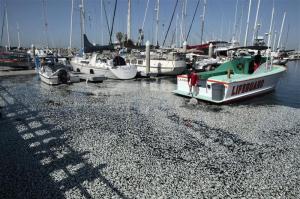
A lifeguard scoops up dead sardines in the harbor area of Redondo Beach on March 8, 2011. (REUTERS/Lucy Nicholson)
Not so long ago, I was sitting at King’s Harbor in Redondo Beach, which is about a ten minute drive from where I grew up in LA. I was drinking a glass of wine at a restaurant on the marina, watching people on their liveaboard boats at sunset, and thinking how great it must be one of them, perpetually barefoot, with a dog that has been wearing the same bandana since 1992, listening to the Eagles. Etc.
I’d like to recant that wishful thinking.
What I — nor they, or any other person, really — could not possibly have forseen that evening was what happened at King’s Harbor on Tuesday, when about a million of sardine swam into the harbor overnight, got trapped, and went belly up the next morning. The fish blanketed the marina floor and coated the water’s surface. In some spots, the fish were as thick as a foot deep.
At this point, authorities and scientists agree that it was a natural event, though the fish are being tested for toxins. But the more likely scenario is that the enormous school of fish were pushed inshore in heavy currents, thrown off their normal path, and moved into the relatively confined space of the marina where there was not enough oxygen to support them. There have been past mass fish die-offs in the area during red tides. But initial water testing has indicated that was not the case on Monday night when residents say the sardines started swarming around their boats. In any case, for the rest of the week, they, city employees and a crew of volunteers will be hauling the fish out by net and wheelbarrow.
The timing — while coincidental — is interesting. A few weeks back, at the annual meeting of the American Association for the Advance of Science (AAAS), a panel predicted that as we continue to take too many large predatory fish from the sea, smaller foraging fish like sardines, anchovies and capelins could become the dominant species in our oceans in the coming decades.
As Bryan wrote about the panel on Ecocentric:
A team of researchers led by Villy Christensen of the University of British Columbia’s Fisheries Centre looked at fishing stats and found that big predatory fish like tuna and cod have declined by more than two-thirds over the past century, while small fish like sardines and anchovies have doubled over the same time period. Of that decline in large fish, 54% took place during the last 40 years, when the big factory fleets really kicked into gear.
That means the smaller fish populations eat more of the ocean’s zooplankton, which means that the plant plankton, eaten by the zooplankton, start growing too fast and using up all the oxygen in the water, creating anaerobic conditions in which other species will find it difficult to thrive.
To stop this dizzying chain of events, Christensen recommends that humans embrace the change. And by that, he means skipping swordfish and tuna for dinner and learning to love forager fish species like sardines and anchovies, which are currently mostly used for fishmeal and feed for aquaculture. (Sardines have a “best choice” rating on the Monterey Bay Aquarium’s Seafood Watch guide to eating sustainable seafood.)
Jamie Oliver is evidently already a sardine fan, as are foodie web sites like Chow and Foodspotting. Personally, I spent my whole life avoiding them until I got to Sicily, where I was talked into a canned sardine sandwich one morning, with some olive oil and tomatoes. I have rarely enjoyed a breakfast so much. Unfortunately, it may be too late for localvores to get into this canned fish in the U.S.; the last sardine cannery in the U.S. shut down in Maine last year, due to global competition and a general lack of enthusiasm for the little guy. Maybe people in Brooklyn can start raising sardines in their backyard ponds.
Anyway, I’m not *really* suggesting that people scoop the sardines out of the Redondo harbor and eat them. (Perhaps they could have, but 24 hours later, that moment has clearly passed. We’re entering into public health hazard territory now.) Nor am I suggesting that billions of sardines are going to continue to wash ashore in marinas up and down the west coast of America because we’re overfishing their natural predators. But it’s not everyday that we are so viscerally reminded that there are a lot of different kinds of fish in the sea. So the next time you’re going for Japanese, skip the toro, and go for the iwashi. Then start a food blog and write about it.


